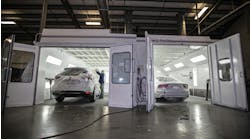An estimate is supposed to be a detailed, accurate and thorough plan of repair for anyone to understand and that arrives at a fair exchange of value. What if it isn't? What if there's a problem? By identifying and clarifying a problem, you can better identify where your argument belongs.
Think of the estimate developing in three steps: from damage to repair plan, from repair plan to paper and from paper to dollars.
The first step is identifying damage, identifying repairs and identifying all steps needed to complete repairs in a safe and approved manner. Is all visible damage included in this loss? How far does the damage go? What is the best way to get that damage out? Is this an approved procedure? Is this part repairable? Is salvage part use practical? What refinishing steps are needed?
Problems here are an issue of technical information, procedures and opinions. Differences could arise between any of the relevant people involved, including technicians, shop estimators and insurance estimators.
Experience is helpful in resolving technical issues, but documentation is proof positive. Printed information from I-CAR, vehicle manufacturers, material suppliers and other credible sources may be needed to back up your point. If an insurance estimator doesn't have authority to override his or her office's policy, your argument may need to go up the insurance chain of command. Be sure you can prove your point.
The next step is getting all those repair decisions down on paper accurately. Are all repairs entered into the estimate? Are all options identified? What must be entered manually? What replacement part type is most practical? Is it available?
Problems here are an issue of estimating system knowledge and procedure page information. Differences may easily arise when each party does not have the same estimating system. This is where knowledge of each estimating system is important and knowledge of its procedure pages is critical. This is true whether writing, reading or using this estimate. Know how to identify repair and part types. Know what is included and what is not included. Know what the estimating program does, what its setup choices are and what the writer's choices are. Know how to identify computer-generated amounts vs. estimator judgement amounts. Questions about pre-stored labor and parts information may need to be referred to the information provider.
The final step is putting dollar amounts to those repair operations for a fair exchange of value — quality repairs for adequate compensation. What labor rate do you need? What labor rates are practical in your market? Will you accept the labor rate offered? Is the material allowance adequate? Are materials allowed for stripes, corrosion protection and any custom work? Are the right items taxed at the right rates? Is the bottom line okay?
Problems here are negotiation issues. This is difficult because it is person-to-person discussion with support only from rules or policies made by yet another person (claims management or shop management). Remember some basic elements of negotiation:
- Agree that your mutual goal is quality repairs at a reasonable price.
- Challenge specific issues or decisions, not the person. Stick to the facts.
Are you prepared to walk away rather than take the job just to keep busy? After all, you are not in business to give things away, nor to take unfair advantage of those less knowledgeable. A steady, honest profit keeps a business healthy and better able to serve its customers.
Bruce Burrow, AAM started writing estimates over 30 years ago, has worked for most of the information providers, and, as an independent instructor for the last 10 years, has trained estimators all across North America. He is ASE Master certified and an instructor for the Automotive Management Institute. Send questions, ideas, and comments that you would like to see addressed here to [email protected] and stay tuned.




